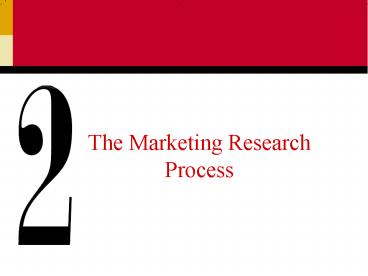The Marketing Research Process - PowerPoint PPT Presentation
1 / 20
Title:
The Marketing Research Process
Description:
Step One: Establishing the Need for Marketing Research. Step Two: Defining the Problem ... Step Five: Identifying Information Types and Sources ... – PowerPoint PPT presentation
Number of Views:560
Avg rating:3.0/5.0
Title: The Marketing Research Process
1
The Marketing Research Process
2
The Marketing Research Process 11 Steps
- Step One Establishing the Need for Marketing
Research - Step Two Defining the Problem
- Step Three Establishing Research Objectives
- Step Four Determining Research Design
- Step Five Identifying Information Types and
Sources - Step Six Determining Methods of Accessing Data
3
The Marketing Research Process 11 Steps
- Step Seven Designing Data Collection Forms
- Step Eight Determining Sample Plan and Size
- Step Nine Collecting Data
- Step Ten Analyzing Data
- Step Eleven Preparing and Presenting the
Final Report
4
The Marketing Research Process 11 Steps
5
Steps in the Marketing Research Process
- Steps
- 1 Establish Need
- 2 Define Problem
- 3 Research Objectives
- 4 Determine Design
- 5 Identify Information Sources
- 6 Decide Data Collection Method
- 7 Design Questionnaire
- 8 Determine Sample Plan Size
- 9 Collect Data
- 10 Analyze Data
- 11 Write and Present Report
Figure out what to research (Chapters 2 4)
Design the way to do the research (Chapters 5-13)
Gather data from respondents (Chapter 14)
Generate findings and interpret them (Chapters
15-20)
6
The Marketing Research Process
- An 11-step process there is nothing
- Not all studies use all 11 steps
- Few studies follow the steps in order
magic
about 11 steps
7
Step 1 Establish the Need for Marketing Research
- Is there a real need for marketing research?
- Research takes time and costs money.
- Marketing research is not always needed.
8
Step 1 Establish the Need for Marketing Research
- When is marketing research not needed?
- The information is already available.
- Decisions must be made now.
- We cant afford research.
- Costs outweigh the value of marketing research.
9
Step 2 Define the Problem
- This is the most important of the 11 steps.
- If the problem is incorrectly defined, all else
is wasted effort. - Problems may be either specific or general.
10
Step 2 Define the Problem
- Problems stem from gaps between what is supposed
to happen and what did happen and gaps between
what did happen and what could be happening.
11
Step 3 Establish Objectives
- Research objectives, when achieved, provide the
information necessary to solve the problem
identified in step 2. - Research objectives state what the researchers
must do.
12
Step Four Determine Research Design
- Exploratory Research collecting information in
an unstructured and informal manner. - Descriptive Research refers to a set of methods
and procedures describing marketing variables. - Causal Research (experiments) allows isolation
of causes and effects.
13
Step 5 Identify Information Types and Sources
- Primary information information collected
specifically for the problem at hand - Secondary information information already
collected
14
Step 6 Determine Methods of Accessing Data
- Secondary data is relatively easy to access
primary data is more complex. - Three main choices for primary data
- Have a person ask questions
- Use computer assisted or direct questioning
- Allow respondents to answer questions themselves
without computer assistance
15
Step 7 Design Data Collection Forms
- Questionnaire must be worded objectively,
clearly, and without bias in order to communicate
with respondents. - Software programs are available to assist
marketing researchers in preparing forms.
16
Step 8 Determine Sample Plan and Size
- Sample plan refers to the process used to select
units from the population to be included in the
sample. - Sample size refers to determining how many
elements of the population should be included in
the sample.
17
Step 9 Collect Data
- Data collection is very important because,
regardless of the data analysis methods used,
data analysis cannot fix bad data. - Nonsampling errors may occur during data
collection.
18
Step 9 Collect Data
- Data collection errors may be attributed to field
workers or respondents. - Researchers must know the sources of these errors
and the controls to minimize them.
19
Step 10 Analyze Data
- Data analysis involves entering data into
computer files, inspecting data for errors, and
running tabulations and various statistical
tests. - Data cleaning is a process by which raw data are
checked to verify that the data have been
correctly inputted from the data collection form
to the computer software program.
20
Step 11 Prepare and Present the Final Research
Report
- The last step is one of the most important phases
of marketing research. - Its importance cannot be overstated because it is
the report, or its presentation, that properly
communicates the results to the client.































